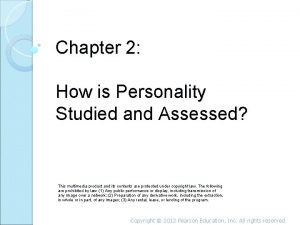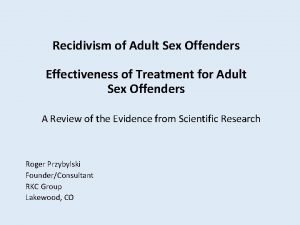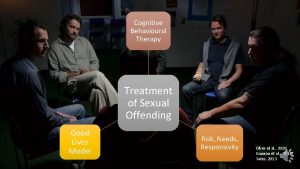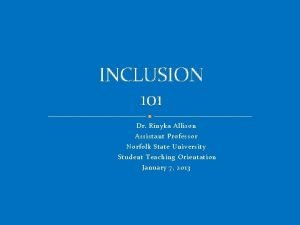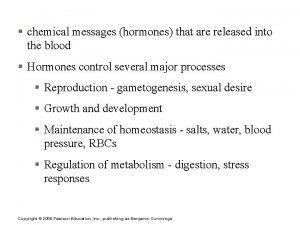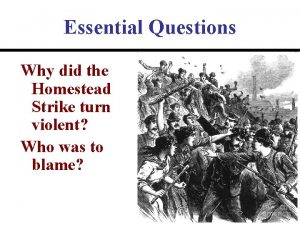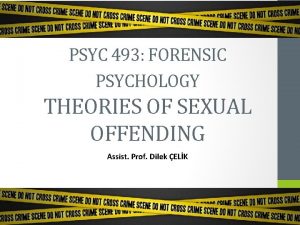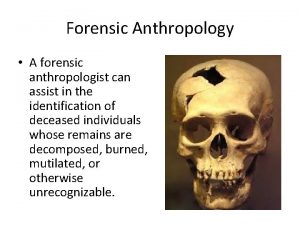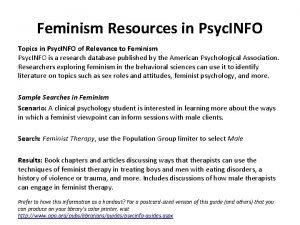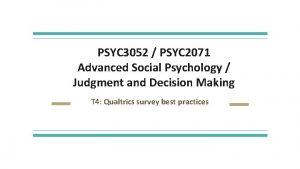PSYC 493 Forensic Pychology Violent Offenders Assist Prof






























































![Most frequently selected victims [Hickey (2002; 399 serial killers)] Strangers (70%) 1. College students, Most frequently selected victims [Hickey (2002; 399 serial killers)] Strangers (70%) 1. College students,](https://slidetodoc.com/presentation_image_h2/8b6272ae762ced780868bc498adc615a/image-63.jpg)




- Slides: 67

PSYC 493 - Forensic Pychology Violent Offenders Assist. Prof. Dilek ÇELİK

Definitions Serial killer: A person who kills three or more people in three or more separate events over a period of time including an "emotional cooling-off" period in between the homicides (FBI definition) Mass Murder: The USA Bureau of Justice Statistics defines a mass murder as "[involving] the murder of four or more victims at one location, within one event without cooling off period. It is the act of murdering a number of people, typically simultaneously or over a relatively short period of time and in close geographic proximity.

Definitions • Serial Murderer (Fergusson) • Three or more victims are killed during multiple and discrete events. • Killing the victim is pleasurable to the offender at the time. It may be stress-relieving or otherwise consistent with the perpetrator’s internal set of values. The attacks themselves do not fulfil only functional purposes. • The murders do not occur under the direction or blessing of any political or criminal organisation.

Common Terms • Modus Operandi – the operating technique used by the offender. The actions necessary to commit murder. • Signature – The signature is often referred to as the “calling card” of the offender. The person goes beyond what is necessary to commit the crime, i. e. burglarise and defecate home, stab a number of times. • 1. Charles Albright, “The Eyeball Killer”- removal of the eyeballs The Signature: Smiley faces left at crime scenes The Crimes: Retired New York City detectives Kevin Gannon and Anthony Duarte believe they’ve found a terrifying pattern among 45 cases of accidental drownings in the Midwest: frequently, the men were popular, athletic, and walking home after drinking at a party or bar in the winter. And in at least a dozen cases, smiley face graffiti was found near the crime scene.

Common Terms • Staging – Altering the crime scene to throw the investigation, this may happen with organised offenders. • Undoing – Undoing usually takes place when there is a close relationship between the victim and offender. As if the victim is alive… • Concept of Escalation • The concept of escalation involves an increase in the intensity of criminal behaviour. Crimes start at a minor level and progress to worsening levels. Burglary is often correlated with murder.

Classification of Murderers • Patterns of Murderers: Organised Vs. Disorganised (Nonsocial vs. Asocial) • Schlesinger categorises Organised and Disorganised offenders according to: § Crime scene characteristics § Personality characteristics

Classification of Offenders ORGANISED DISORGANISED VICTIMS Targeted Victim– Single White Female. Planned Anybody – very poor relations with women in general. Usually live alone. CRIME SCENE Crime scene staged, and transport body No staging, leave body where killed. WEAPON May carry weapon with him, and take them away after the crime, i. e. rape kits Uses weapon of opportunity, frenzied attack, often depersonalizes the victim, i. e. turn them on their stomachs

Classification of Offenders ORGANISED DISORGANISED CHILDHOOD Troublemaker at school. Classmates won’t remember the offender. PERSONALITY Externalized anger, often attractive, confident, intelligent, good verbal skills. History of problems with authority. Internalized anger, physically unattractive, low self-esteem, and previous suicide attempts, not very articulate in conversation. RELATIONSHIPS WITH WOMEN Talks to women, mood is fairly controlled. Doesn’t often talk to women, mood is anxious

Classification of Offenders ORGANISED DISORGANISED PLACE OF RESIDENCE Live some distance from the crime, except the first crime, as it is close to home and more comfortable. Usually live with a woman. Kills where there is familiarity, usually close to home or to work. Lives alone. PRE-OFFENCE May be precipitated by loss of job or break-up with partner. Low self-esteem comes on victim of opportunity. PUBLICITY Takes interest in media reports of crime, will often try to get involved with the police investigation No interest in media reports of crime.

THEORIES OF HOMICIDE • • Societal level theory Psychological disposition theory Socio-biological theory Multi-factorial approach

Societal Level Theory

Societal Level Theory • Leyton argued that multiple killings are indicative of homicidal protest. This is essentially that at different times in history a (social) class becomes under threat from another social class

Psychological Predisposition • After studying murderers in a psychiatric prison hospital, Blackburn (1971) suggested that there are four types of murder: • • paranoid-aggressive; • • depressive; • • psychopathic; • • over-controlled repressors (of aggression).

Psychological Predisposition • MMPI (Minnesota Multiphasic Personality Inventory) • • Normal profiles (28%). • • Hypersensitive-aggressive (49%): this group consists of people with the characteristics of being easily offended, prone to impulsive aggressive outbursts and intolerant of frustration. They are very rigid, uncooperative and permanently dissatisfied with things.

Psychological Predisposition • MMPI (Minnesota Multiphasic Personality Inventory) • • Psychopathic (17%): these tend to score highly on emotional instability, impulsivity and immaturity. They tend to have poor control of their aggression. • • Psychotic (5%): these seem to be ‘mistakes of the system’ since they are individuals who show extreme psychiatric signs and would normally have been confined to a special psychiatric unit. Their crimes appear to be bizarre such as the man who cooked his own child in a pot.

Socio-biological Theory • Testesterone level and aggressiveness • Gender differences • Natural selection and adaptive construction explanation for homicide • For example, step-parents may murder children of the family more often simply because the stresses in step-parent families are likely to be greater.

Multi-factorial Approach

The Serial Murderer: A General Profile • One of the most disturbing features of the phenomenon of serial killing is that the murderers themselves seem rather ordinary -- at least on the surface. • Often of average height, weight and appearance. • They can seem calm and reasonable, polite and friendly • Most are of good intelligence, though few are educated beyond high school or vocational school • Usually middle- to lower-middle class

The Serial Murderer: A General Profile • The great majority of serial killers are Caucasian and male. • A small fraction have been women. • About ten percent of serial murderers have been African American, although their numbers seem to be growing. • Between two to three percent have been Latino, Asian, or Native American.

The Serial Murderer: A General Profile • The thinking of these offenders is dominated by violent, sexualized fantasies of revenge and control, which often start in childhood. • Emotionally, they are characterized by deep-seated frustration, fear, hostility, anger, lack of self-esteem, and depression. • Many are loners and self-preoccupied.

John Wayne Gacy- murdered 30 boys

Defining Serial Murder: The Number of Serial Killers • The FBI estimates the number of offenders in any given year to be thirty-five, though it may be as high as 100 -- or even more • The number of identified serial killers has surged since the late -1960 s

The Number of Serial Killers Difficult to determine due in part to: Ø Serial murderers are often active for a period of a year or more. ØThe pattern linking individual homicides may not be apparent at first to law enforcement. ØThe killings may occur in several different legal jurisdictions, which may hamper efforts at detection

Categorizing Serial Murders and Murderers The FBI identifies serial killers as: Ø “Organized" (those who carefully plan and execute their murders) or Ø“Disorganized" (those who kill spontaneously).

TYPES & MOTIVES R. Holmes and J. De. Burger (1988) and R. Holmes and S. Holmes (1996) developed a theory that serial murders may be classified into four categories based on motive.

1 -VISIONARY • These serial killers generally suffer from a form of psychosis where their delusions or hallucinations command them to kill. Herbert Mullin is an example of a visionary serial killer who believed voices told him to kill in order to prevent an earthquake. He also burned his penis with a cigarette because voices told him to do so. • responding to voices or visions

2 -MISSION-ORIENTED Mission serial killers murder because they are motivated to seek revenge or eliminate a particular group of people. Their motives are generally not created out of psychosis. Carroll Edward Cole is an example. His mission was to kill women who cheated on their partners and he killed at least 13 women who had sex with him.

2 -MISSION-ORIENTED Adnan Çolak killed 11 people in Artvin and its districts between 19921995. Çolak's victims were between 68 -95 years old. Colak raped six women he killed. He became known as "the ax killer" and "Artvin Monster" because of the weapon he used during the attack. The wounded survivor was caught by one of the victims. In the trial he was tried, he said, "If I kill old people, they are already out of their time. They live extra for us. Maybe they eat our fortune. society by killing them as well I was comforting, "he said. Adnan Çolak 5 -year trial eventually sentenced to 112 years in prison banged but publicly Known as "Rahşan Amnesty" He was released on 28 May 2005, under provisional release.

3 -HEDONISTIC Hedonistic serial killers are driven by the thrill/rush, lust/sexual pleasure or gain (such as financial) brought on by murder. "Killing is an eroticized experience fueled by the linking of sex and violence in the developmental history of the offender, " writes Jacqueline B. Helfgott (in her book Criminal Behavior - Theories, Typologies and Criminal Justice). Black widows fit into this category, such as Lydia Trueblood who killed five husbands and her baby daughter. Jeffrey Dahmer is another example of a hedonistic serial killer. His crimes involved the murder of 17 young men and boys coupled with rape and necrophilia.

4 -POWER & CONTROL-ORIENTED • These serial killers murder due to the satisfaction they gain of having complete power over their victims. Sex is often part of this type of serial murder. Ted Bundy, who confessed to murdering 30 women (as well as kidnapping, raping, mutilating and having sex with them after they were dead), is an example of a power/control serial killer. •

Categorizing the Killers: The Organized Killer ØThe hardest to catch. ØSocially adept ØAverage in appearance, height, and weight ØDresses neatly ØPrefers to use verbal means -- rather than force -- to capture his victims and very often succeeds.

Categorizing the Killers: The Organized Killer ØMethodically planned murders ØA sexual sadist whose main goal is to gain control over his victim through rape, other sexual assaults, and eventually murder. ØControl over the victim is seen in the use of restraints, including rope, chains, tape, belts, handcuffs, chemicals, gags, and blindfolds. ØFantasy and ritual predominate in the organized offender.

Categorizing the Killers: The Organized Killer ØObsessive, compulsive traits surface in the commission of the crime. ØThe killer carefully avoids leaving evidence behind and often moves the body from the death scene. ØDuring the commission of his crimes, he reports being calm and relaxed.

Categorizing the Killers: The Organized Killer ØComes from a relatively stable, lower-income family and is often the firstborn son. ØInconsistent parental supervision. ØUsually better-than-average intelligence, sexually active, and lives with a partner. ØFollows the investigation of his crimes in the media.

Ted Bundy- murdered 30 women

Categorizing the Killers: The Disorganized Killer Typically, the disorganized offender: • Is preoccupied with recurring obsessive thoughts • Seems confused and distressed at the time of the crime. • Fearful of people and has developed a highly-defined delusional system. • Acts impulsively under stress. • Is of below average intelligence and has a poor history of work. • Frequently lives alone or with a parental figure and lives in close proximity to the site of his murders. • Is socially inadequate and often incompetent sexually. • May have pronounced sexual aversions.

Categorizing the Killers: The Disorganized Killer The disorganized offender: • Commits crimes suddenly • Leave the crime scene in great disarray; it has a spontaneous, symbolic, unplanned quality • Generally, kills quickly in order to have control, catching the victim completely off guard. • Depersonalizes the victim and specific areas of the body are targeted for extreme brutality. Overkill (the infliction of more injury than necessary to kill) and mutilation of the face are common. • Generally performs sexual acts after death. These may include mutilation of the genitals and breasts, disembowelment, vampirism, or substitute sex acts such as the insertion of objects into the victim's body cavities.

Richard Trenton Chase- The Vampire of Sacramento

Categorizing the Killers: Team Killers • Over one third of all serial murders are committed by teams • Most involve two offenders, and some groups have as many as five • One third of all team murderers are legally or blood-related (siblings, husbands and wives, lovers, even parents and their children) • Women make up thirty-eight percent of these groups. • Eleven percent have been African American

Categorizing the Killers: Team Killers Examples: • • Kenneth Bianchi and Angelo Buono's "Hillside Stranglers" Henry Lee Lucas and Otis Toole Douglas Clark and Carol Bundy Charles Manson and his "Family. "

Categorizing the Killers: Team Killers Without exception, every group of offenders has one person who maintains control of the other members, whether through coercion, intimidation, or other persuasive techniques. Nearly all of these "leaders" are men. Although women are frequently involved with serial murder teams, they generally are not the decision-makers or main enforcers.

Categorizing the Killers: Team Killers At what point does a person agree to murder victims? What enables someone to convince others to murder? It seems unlikely that some male and female offenders would ever have committed these crimes if they had not been exposed to group dynamics and the power of persuasion and manipulation. Some people who led groups of team offenders experienced a sense of power and gratification not only through the deaths of victims but also through getting others to do their bidding.

Ian Brady & Myra Hindle

Categorizing the Killers: Female Serial Killers • Women represent only a small fraction of the total number of serial murderers who have been apprehended • Since the 1970 s there has been a notable increase in the number of female serial killers

Categorizing the Killers: Female Serial Killers • Female serial murderers are usually white • They are generally older when they start killing and tend to keep active over a longer time. • They are as likely to kill within their families as they are to kill strangers. • When killing within the family, husbands are their primary victims • Twelve percent kill children only

Categorizing the Killers: Female Serial Killers The majority of these killers fall into two categories: • “Black widows" Ø Women who kill their husbands, children, or other relatives. • Nurses and caretakers Ø Victimize people over whom they have control Ø Elderly men and women, and especially babies, are their primary targets. Ø They can also be nurses or other medical professionals who become self-appointed "angels of death" murdering babies, elderly, or the desperately ill in a misguided effort to relieve their suffering.

Categorizing the Killers: Female Serial Killers • Women do not, as a rule, sexually assault their victims. • Fantasy may play a role in their murders • Female serial killers are generally less violent than male serial killers. • Nearly half of female serial killers poison their victims • Although some women do commit the brutal acts more commonly associated with serial murder, it is usually when working in tandem with men.

Aileen Wuormos

Categorizing the Killers: Roaming Serial Killers • Only a minority of serial murderers travel widely in committing their crimes • Half of all male serial killers are so-called "local" offenders, staying within the general area of their cities or counties and never carrying on their killing in more than one state • Twenty percent of serial murderers are "place-specific, " using their homes or places of employment as killing sites. • Less than one third kill victims in more than one state • Female serial killers are predominantly place-specific • early half of all victims were murdered by local killers

Pedro Lopez

Family History and Childhood Trauma • Childhood poverty was not a factor for most serial murderers. The majority of them report growing up in homes with stable, if modest, incomes. • Over three quarters of convicted serial killers come from families with histories of alcohol and drug abuse. • Over half had family histories of psychiatric disorders • Half of their families had members who were involved with criminal activities, from selling drugs to murder. These were homes characterized by violence and neglect. • Nearly all offenders experienced a high level of physical and psychological abuse from their parents and older relatives.

Family History and Childhood Trauma • A majority were sexually abused as children, often by members of their families. • Many were subjected to strict discipline and humiliating punishment. • Seventy percent had to undergo psychiatric evaluation or confinement as children and teens. • These troubled homes were further disrupted by divorce or separation and often by re-marriage. • One third of these offenders grew up in a single location. • Forty percent of serial murderers had lived outside of their family homes before the age of 18 -- in foster homes, state homes, detention centers, or mental institutions.

Effects of the Family Child Abuse Comparison of Serial Killers to the General Population (Mitchell & Aamodt, 2004) Type of Abuse General Population Serial Killers Physical 6% 36% Sexual 3% 26% Psychological 2% 50% Neglect 18% Other 6% Not applicable No Abuse Reported 70% 32%

Charles Manson

Childhood Behavior Common attitudes and behaviors of children who grow up to be serial murderers are: • Rebelliousness • Aggression • Assaultive actions towards adults • Chronic lying • Daydreaming • A sense of privilege or entitlement • Compulsive masturbation and other autoerotic activities are also commonplace. These behaviors intensify with adolescence and ultimately become habitual by adulthood.

Childhood Behavior Cruelty towards animals and other children often sets the stage for greater abusiveness in the future. Arson- Fire setting Bedwetting -- when seen in combination with expressions of cruelty are believed by some experts to be crucial contributors to the development of a serial murderer. TRIAD!!

Henry Lee Lucas

Sexual Fetishes Fetishism is the finding of sexual gratification through substituting objects for a sexual partner. • In one survey of convicted serial murderers, seventy-two percent report having sexual fetishes. • As young boys, many adult serial murderers report having had strong attraction to high-heeled shoes, female underwear, and rope. As adolescents and into adulthood, they take repeated sexual interest in these items. Eventually, these objects become part of the ritualized aspects of their murders. • Some offenders remove the breasts of their victims and keep them as fetish objects. Others keep hair, teeth, heads, fingers, and sexual organs.

Jerome Brudos

Committing Serial Murder: The Role of Fantasy • For both the organized and disorganized serial murderer, early fantasies combining violence and sex become more elaborate with time. • By adulthood, they are the central feature of his life, the means through which he encounters the world and validates his own actions.

Committing Serial Murder: The Role of Fantasy • For the serial murderer, early fantasies combining violence and sex become more elaborate with time. By adulthood, they are the central feature of his life, the means through which he encounters the world and validates his own actions.

Serial murder Films USA Decade No. of films 1920 s 1930 s 1940 s 2 1950 s 1960 s 1970 s 1980 s 1990 s 4 12 20 23 64 3 3 62
![Most frequently selected victims Hickey 2002 399 serial killers Strangers 70 1 College students Most frequently selected victims [Hickey (2002; 399 serial killers)] Strangers (70%) 1. College students,](https://slidetodoc.com/presentation_image_h2/8b6272ae762ced780868bc498adc615a/image-63.jpg)
Most frequently selected victims [Hickey (2002; 399 serial killers)] Strangers (70%) 1. College students, prostitutes 2. Little boys and girls 3. Hitchhikers 4. People at home 5. Handicapped people 6. Store-owners, landlords 7. People walking street 8. Older women 9. Police officers 10. Derelicts/transients 11. People responding to newspaper ads Acquaintances (20%) 1. Friends and neighbours 2. Girlfriends and boyfriends 3. Waitresses and prostitutes 4. Co-workers 5. Landlords, employers, guards 6. Gang members 7. Patients Family (10%) 1. Own children 2. Husbands 3. Wives 4. In-laws 5. Nephews, nieces 6. Own mother 7. Sibling 8. Grandparents

Male Serial Killers(399): Methods • 1. Firearms mainly (41%) • 2. Suffocation (37%) • 3. Stabbing (34%) • 4. Bludgeoning (26%) • 5. Firearms only (19%) • 6. Poison (11%) • 7. Drowning (3%) • 8. Other (2%) Motives • 1. Sex (55%) • 2. Control (29%) • 3. Money (19%) • 4. Enjoyment (16%) • 5. Racism and hatred (11%) • 6. Mental problems (6%) • 7. Cult-inspired (5%) • 8. Attention (2%)

Female Serial Killers (62): Methods • 1. Poison (80%) • 2. Shooting (20%) • 3. Bludgeoning (16%) • 4. Suffocation (16%) • 5. Stabbing (11%) • 6. Drowning (5%) Motives • • • 1. Money (74%) 2. Control (13%) 3. Enjoyment (11%) 4. Sex (10%) 5. Drugs, cult involvement, cover up, or feelings of inadequacy (24%)

Theodore J. Kaczynski • The Unabomber is the nickname given to American domestic terrorist Ted Kaczynski, who conducted a 17 -year series of attacks, using mail bombs to target academics, business executives and others. The Unabomber bombing campaign – which killed three people and injured 23 – started in the late 1970 s and continued until Kaczynski was caught in 1996 following a nationwide manhunt led by the Federal Bureau of Investigation (FBI). His capture marked the end of the FBI’s longest and most expensive manhunt.

Theodore J. Kaczynski • It was during his time at Harvard that Kaczynski also participated in a controversial study led by psychologist Henry Murray. • In the experiment, subjects were asked to write an essay on their personal philosophies. Later, while hooked up to electrodes to measure their physiological response, the study subjects were subjected to hours of insults and personal attacks. • The essays were used as a basis for the insults. • It’s believed that Kaczynski participated in this experiment for more than 200 hours, lasting for three years beginning in 1959, and that his mental and emotional well-being suffered as a result.
 Friar laurence character traits
Friar laurence character traits These violent delights will have violent ends
These violent delights will have violent ends Pychology test
Pychology test Thomas mocker and thomas stewart
Thomas mocker and thomas stewart Who is this
Who is this Individual delinquency
Individual delinquency Cognitive behavioral therapy for sex offenders
Cognitive behavioral therapy for sex offenders Juvenile offenders comprehension check answers
Juvenile offenders comprehension check answers Young offenders act
Young offenders act Youthful offenders act 1854
Youthful offenders act 1854 Cognitive behavioral therapy for sex offenders
Cognitive behavioral therapy for sex offenders A custodial institution for young offenders.
A custodial institution for young offenders. Sda hymnal 524
Sda hymnal 524 Round 160 656 to the nearest hundred thousand
Round 160 656 to the nearest hundred thousand Round 493 295 to the nearest ten thousand
Round 493 295 to the nearest ten thousand Round 2 617 to the nearest ten
Round 2 617 to the nearest ten Sda hymn
Sda hymn Psyc 1504 final exam
Psyc 1504 final exam Psyc 2307
Psyc 2307 Psyc 1504 final exam
Psyc 1504 final exam Psyc info
Psyc info Psyc 311
Psyc 311 Psyc info
Psyc info Psyc 1020
Psyc 1020 Psyc info
Psyc info Psyc 1504 final exam
Psyc 1504 final exam Psyc 311 study guide
Psyc 311 study guide Criminology major sfu
Criminology major sfu Psyc 2120
Psyc 2120 Psyc 311 textbook notes
Psyc 311 textbook notes Psyc info
Psyc info Educational sport psychology specialists
Educational sport psychology specialists Info assist
Info assist A coaching relationship focuses on providing marines
A coaching relationship focuses on providing marines Business essentials smbs springchambers9to5mac
Business essentials smbs springchambers9to5mac Esmeralda guia premium
Esmeralda guia premium Brakes unit 3 quiz 1
Brakes unit 3 quiz 1 Sadlier level d unit 1 synonyms
Sadlier level d unit 1 synonyms Cisco smart assist
Cisco smart assist A helpful way for an na to respond to hallucinations is to
A helpful way for an na to respond to hallucinations is to Is a violent disturbance in the atmosphere
Is a violent disturbance in the atmosphere Park assist 2
Park assist 2 Missionassist
Missionassist Vir form
Vir form One teach, one assist pros and cons
One teach, one assist pros and cons What does pam assist stand for
What does pam assist stand for Violent downdrafts that are concentrated in a local area
Violent downdrafts that are concentrated in a local area Quality assist
Quality assist Kristiina jokinen
Kristiina jokinen If a child washes his hands, he could eat with kings.
If a child washes his hands, he could eat with kings. Pbx call assist 2
Pbx call assist 2 Violent vs nonviolent restraints
Violent vs nonviolent restraints Peer assist
Peer assist The whips assist the party leaders by
The whips assist the party leaders by Humoral stimulus
Humoral stimulus Pengertian model
Pengertian model Conclusion of violence
Conclusion of violence Mediassistindia login
Mediassistindia login Word study denotation and connotation
Word study denotation and connotation Assist user guide
Assist user guide Thesis statement on gun control
Thesis statement on gun control Assist electrical
Assist electrical Why did the homestead strike turn violent
Why did the homestead strike turn violent Emory cr assist
Emory cr assist Gx assist side effects
Gx assist side effects Violent video games
Violent video games Non violent crisis intervention techniques
Non violent crisis intervention techniques Als assist
Als assist


